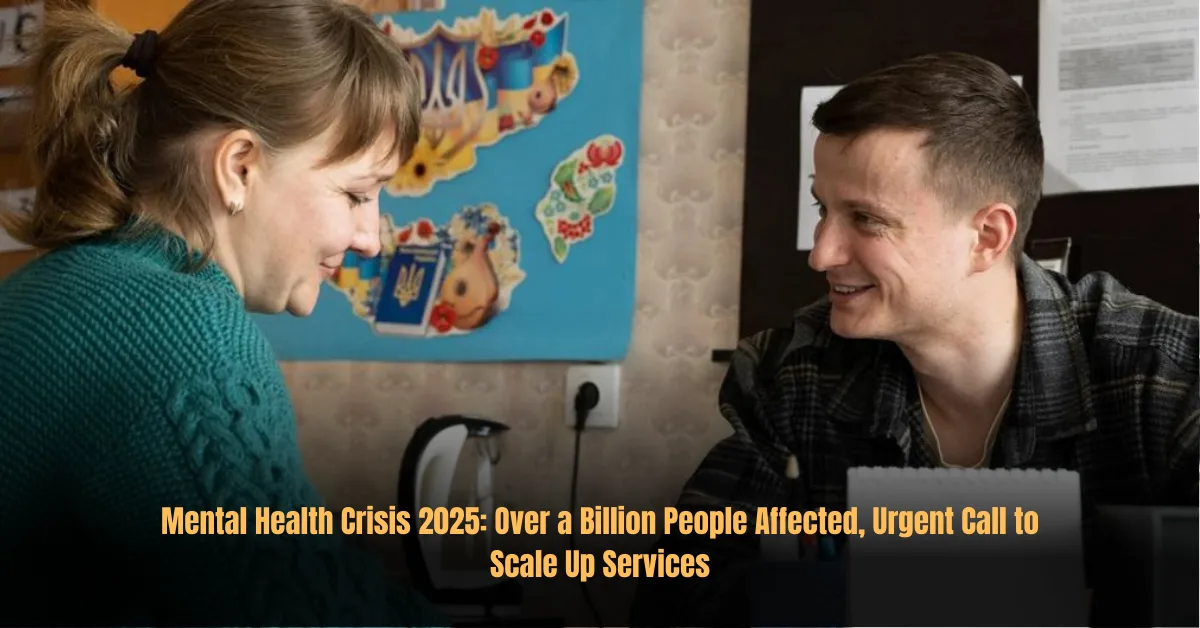Mental Health Crisis 2025: Over a Billion People Affected, Urgent Call to Scale Up Services
The Invisible Tsunami: Unveiling the 2025 Mental Health Crisis
The world today is full of big problems. We have seen global pandemics, political fights, and fast changes in technology. But there is another crisis that many people do not see. This is the mental health crisis of 2025.
This crisis is not in the future. It is happening now. More than one billion people around the world are suffering from mental health problems. This is not only about health. It also affects families, schools, jobs, and even the world economy.
We talk more about mental health today than before. But the action taken is still not enough. In this article, we will look at the numbers, the reasons, and the possible solutions for this crisis.
A World Under Strain: One Billion and Counting
The WHO report of 2025 shows that more than one billion people are living with a mental health disorder. This is a very big number.
The most common problems are anxiety and depression. These are now the second biggest reason for long-term disability. This means people cannot work well or live fully because of these problems.
The cost is very high. Families lose happiness. People lose hope. But the economy also loses money. Mental health problems cost the world about $1 trillion every year because people cannot work properly.
Still, governments do not spend much. On average, only 2% of health budgets go to mental health. This has not changed since 2017. Clearly, mental health is not given enough importance.
The Silent Pandemic: Why Mental Health Is Today’s Defining Health Challenge
During COVID-19, the focus was on physical health. But at the same time, mental health problems were growing quietly.
The pandemic left deep scars. Many people lost loved ones. Many lost jobs. Many faced money problems. All of this increased stress, sadness, and fear.
Now, many people live with constant worry and depression. The mix of personal struggles and world problems has made mental health one of the biggest health issues of our time.
More Than Numbers: The Human and Economic Toll
The numbers look very serious. The WHO suicide report of 2025 says that suicide causes more than 1 in every 100 deaths worldwide.
But behind every number is a real person. A person with family, dreams, and life. Mental illness is not just a private issue. It is also about human rights. Every person deserves the chance to live a good life.
The Domino Effect: Understanding the Drivers of the Crisis
This crisis has many reasons. It is not from one cause. It is like many dominos falling together. To fix it, we must understand what is pushing it forward.
Navigating the Perfect Storm: Socioeconomic and Political Triggers
There is a close link between poverty and mental health. People who are poor, unemployed, or struggling with money are more likely to feel stress, anxiety, or depression.
Wars, political problems, and economic troubles make things worse. Prices go up, jobs are lost, and people feel more hopeless.
Also, natural disasters like floods, storms, and fires are happening more often. People who go through these disasters often suffer from trauma and need mental health help.

From Burnout to Breakthrough: The Changing Landscape of Work
Workplaces are another big reason for stress. A survey shows that many workers suffer from burnout and mental health problems. But most are afraid to talk about it.
Nearly half of workers worry they will be judged or lose their job if they speak about mental health.
This shows the need for a change at work. Employers should provide better support and create safe spaces. People should not feel shame or fear when they ask for help.
The Echo Chamber Effect: Social Media’s Dual Impact
Social media has two sides. On one side, it helps people connect and find support. On the other side, it also creates loneliness, bullying, and comparisons that make people feel worse.
A new problem is also appearing with AI chatbots. Some people spend too much time with them and start to confuse reality with artificial conversations. Experts call this problem “AI psychosis.” This shows how fast technology can harm mental health.
A Crisis in Disguise: The Unseen Struggle of Our Youth
Young people are among the most affected by the mental health crisis. Reports show that students face heavy stress in school and college.
A Generation on the Brink: Unraveling the Youth Mental Health Crisis
Young people feel constant pressure to perform well in studies. Social media adds more pressure. And the future feels unsafe with job problems, climate change, and global uncertainty.
This has made young people more likely to suffer from anxiety, depression, and self-harm. Some data shows a small drop in sadness among high school students. But overall, the picture is still very worrying.
The Loneliness Epidemic: Social Disconnection in a Hyper-Connected World
Young people are very active online. They seem connected all the time. But in real life, many feel lonely and cut off from true friendships.
Social media shows fake, perfect lives. This makes young people feel their own lives are not good enough. As a result, loneliness is spreading like an epidemic.
Beyond the Diagnosis: Addressing Mental Health in Vulnerable Populations
Not everyone suffers in the same way. Poor people, minorities, and LGBTQIA+ groups are often more affected. They face more problems like discrimination, inequality, and lack of support.
Many also use alcohol or drugs to escape their pain. But this only makes their mental health worse. It creates a double problem: addiction and mental illness together.
Closing the Gap: The Staggering Inequity of Mental Healthcare
The world has a big problem with mental health care. Many people cannot get help when they are sick in the mind. In rich countries, people can get care more easily. In poor countries, most people cannot get care at all.
This is not fair. Mental health is as important as body health. But still, millions of people do not get any help. Some people also feel too scared or ashamed to ask for care. We must understand this problem and try to fix it.
Where Help Is a Luxury: The Global Treatment Gap
The difference between rich and poor countries is very clear. In poor countries, less than 10 out of 100 people with mental health problems get treatment. In rich countries, more than 50 out of 100 people get help.
The reason is simple: there are not enough doctors, nurses, or counselors. On average, the world has only 13 mental health workers for every 100,000 people. This number is very low.
This means billions of people do not get help. For them, care is not a right. It is something very rare, like a luxury that only some can have.
Stigma as a Cage: Why People Are Afraid to Ask for Help
Even when care is available, many people stay quiet. They are afraid of stigma. Stigma means shame and fear about mental health problems.
People worry that others will call them weak or crazy. Some workers hide their problems because they think their boss may fire them or not promote them.
A study on workplace mental health showed many people keep silent about their struggles. This fear is like a cage. It keeps people locked inside their pain. To solve the crisis, we must also fight stigma.
System Overload: The Collapse of Traditional Mental Healthcare Models
Old models of mental health care cannot handle today’s needs. One-on-one therapy and small clinics are too slow.
Hospitals are full, waiting lists are very long, and some poor areas have no clinics at all. This shows the old system cannot work anymore.
We need new ideas. Mental health care must move into schools, jobs, and community places. This will make care easier to reach and less scary for people.
Also Read: Xi Jinping Showcases China’s Military Strength at Beijing Parade 2025
A Workforce on the Verge: Burnout and Shortages Among Mental Health Professionals
The people who give care are also suffering. There are not enough mental health workers, and they are very tired.
Many doctors, nurses, and counselors feel burnout. Burnout means too much stress and tiredness from work. When they feel this way, they cannot give good care. Some even quit their jobs.

This makes the shortage even worse. If we want better services, we must also support the workers.
The Way Forward: A Bold Blueprint for Scaling Up
The crisis is big, but it can be solved. We cannot use the same old tools. We must try new ideas.
Mental health should be treated like body health. Everyone has the right to get care. To close the gap, we need technology, community support, strong laws, and more funding.
Innovation on the Frontlines: The Rise of Digital Therapeutics
Technology is already helping. Online counseling, telemedicine, and mobile apps make care easier to reach.
AI chatbots can give support in the moment when someone feels sad or lonely. Apps can help track moods and give exercises.
These tools are not perfect. Privacy is still a big worry. But digital tools can reach millions of people who do not have doctors near them. This is a strong way to close the care gap.
Embracing the Village: Community-Based and Culturally-Informed Care
Mental health care should not stay only in hospitals. It must be part of everyday life.
We can bring care into schools, offices, and community centers. When people get care in familiar places, they feel safer.
Care must also respect culture. Every country and community has its own beliefs. If care respects these beliefs, people will trust it more.
When whole communities talk about mental health, stigma becomes weaker. People start to help each other, like a big family.
Dollars and Sense: Why Investing in Mental Health is a Smart Economic Strategy
Some leaders think mental health care is too costly. But in truth, it saves money.
The World Health Organization says that for every $1 spent on treating depression and anxiety, the world gets $5 back. This money comes from better work, fewer sick days, and stronger economies.
When people are healthy in mind, they can work harder, learn more, and take care of their families. When mental health is ignored, countries lose billions. So, investing in care is smart.
From Policy to Practice: The Urgent Need for Legal Reform
Laws for mental health are not strong in many places. Insurance companies often give less coverage for mental illness than for physical illness.
This is unfair. Mental health parity laws are needed. These laws will make sure mental health is covered the same way as body health.
In September 2025, the United Nations will hold a big meeting on mental health. This is a chance for leaders to make real promises. They must act now, not later.
The Power of Purpose: A Call to Action for a Healthier World
The mental health crisis is a warning to all of us. It is not just a health issue. It is a human issue. It affects families, schools, jobs, and whole nations.
We all have a role. Governments must spend money on care. Companies must build safe workplaces. Tech firms must design safe tools. Schools must teach children about mental health. And we, as people, must talk openly and kindly.
Mental health is a human right. Everyone deserves care, support, and hope. If we all work together, we can close the gap. We can build a world where no one is left behind.


